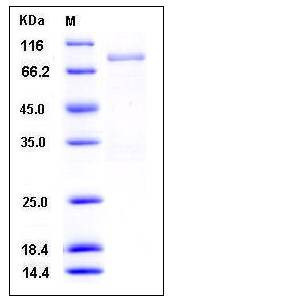Human BLK / B Lymphocyte Kinase Protein (GST Tag)
MODY11
- 100ug (NPP3607) Please inquiry
| Catalog Number | P10782-H09B |
|---|---|
| Organism Species | Human |
| Host | Baculovirus-Insect Cells |
| Synonyms | MODY11 |
| Molecular Weight | The recombinant human BLK/GST chimera consists of 730 amino acids and migrates as an approximatly 84 kDa band as predicted in SDS-PAGE under reducing conditions. |
| predicted N | Met |
| SDS-PAGE |  |
| Purity | > 88 % as determined by SDS-PAGE |
| Protein Construction | A DNA sequence encoding the human BLK (NP_001706.2) (Met 1-Pro 505) was fused with the GST tag at the N-terminus. |
| Bio-activity | The specific activity was determined to be 17.4 nmol/min/mg using Poly(Glu,Tyr)4:1 peptide as substrate. |
| Research Area | Neuroscience |Neurology process |Neurodegeneration and Neurodegenerative Disease |Others in Neurodegeneration and Neurodegenerative Disease |
| Formulation | Supplied as sterile 20mM Tris, 500mM NaCl, 5mM GSH, pH 7.4 1. Normally 5 % - 8 % trehalose and mannitol are added as protectants before lyophilization. Specific concentrations are included in the hardcopy of COA. |
| Background | Tyrosine-protein kinase Blk, also known as B lymphocyte kinase, p55-Blk and BLK, is a member of the protein kinase superfamily, Tyr protein kinase family and SRC subfamily. BLK / p55-Blk is expressed in lymphatic organs, pancreatic islets, Leydig cells, striate ducts of salivary glands and hair follicles. BLK / p55-Blk is a src-family protein tyrosine kinase specifically expressed in B-lineage cells of mice. The early onset of Blk expression during B-cell development in the bone marrow and the high expression levels of Blk in mature B cells suggest a possible important role of Blk in B-cell physiology. It is a modulator of beta-cells function, acting through the up-regulation of PDX1 and NKX6-1 and consequent stimulation of insulin secretion in response to glucose. Defects in BLK are a cause of maturity-onset diabetes of the young type 11 which is a form of diabetes that is characterized by an autosomal dominant mode of inheritance, onset in childhood or early adulthood (usually before 25 years of age), a primary defect in insulin secretion and frequent insulin-independence at the beginning of the disease. |
| Reference |
